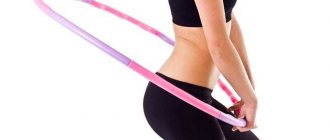The number of workouts per week is calculated individually for each person. It depends on a person’s physical activity, his workload, the goals he pursues, and of course, his state of health. The article will outline recommendations for a healthy person with an average workload.
The optimal frequency of training is most often determined by the main purpose of visiting the gym. It is this factor that affects how many days our body needs to recover. Let's see how many times it's better to train per week. Training frequency is determined by the number of workouts of a given muscle group or lifts per unit of time.
We recommend reading: What foods contain a lot of protein?
How often to train a muscle group[edit | edit code]
Muscle Training Frequency
Many people wonder how often a muscle group should be trained to achieve maximum muscle growth? Opinions are very polar, some argue that the optimal frequency of training one muscle group is no more than once a week (for example, the super training system), otherwise you will overtrain and not recover, others cite the example of lifters and weightlifters who squat 2-5 times per week and growing.
A meta-analysis on this topic was published in 2021. Ten studies published in English-language peer-reviewed journals were analyzed, comparing different training frequencies in traditional dynamic and eccentric movements, a minimum duration of 4 weeks, and participants without chronic diseases or injuries.
Conclusions:
Statistical processing of the results showed that the frequency of training significantly affects the amount of muscle hypertrophy, with a higher frequency associated with a more pronounced effect. When compared to studies that compare training a muscle group 1 to 3 times per week at the same training volume, current evidence suggests that training 2 times per week results in greater hypertrophy than training once per week.
We can confidently say that the main muscle groups need to be trained at least 2 times a week for maximum growth
. At the same time, we cannot yet say that three workouts a week will be better than two.
How many times per week to train for weight?
If you want to build muscle mass, the emphasis should be on strength training. They should devote 3-4 days a week. The main rule is not to train the same muscle group several days in a row. Use splits. This is a training program method that involves performing exercises on different muscle groups on different days.
Example of a weekly plan:
- Monday Upper Body Exercises
- Lower body exercises on Tuesday
- Recovery Day (Wednesday)
- Repeat the same division on Thursday and Friday
Each muscle group - 2 times a week
This brings us to the golden mean, ideal for most amateurs - training each group, on average, twice a week or once every five days. This allows you to create the required training volume and maintain high intensity, as well as have time to recover.
The most popular division of muscles is “top” and “bottom”. But there are other options.
We recommend reading: Abdominal superset
If you are not gaining muscle as quickly as you would like, you may be experiencing a plateau effect. To put it simply, this is a “period of stagnation.” When the same muscles are trained over a long period of time, identical exercises are performed with the same weight, there is a high chance that the body and metabolism will adapt. Also, the reason for the lack of results can be overtraining, genetics, incorrect and ineffective exercise technique.
To get back to the muscle building phase, you need to change something. Several ways to fix the situation:
- Increase the weight in your workouts
- Add new exercises to your routine
- Change the number of sets and reps you perform
Periodization of training[edit | edit code]
The principle of planning the frequency of training
The frequency of training in bodybuilding is categorically different from periodization in any other sport. Because, firstly, at different stages the athlete is given two directly opposite tasks: to gain weight and to lose weight. They can be combined into one cycle, but it is better to separate them. In addition, preparing for competitions is not just banal weight loss, it is an attempt to reduce the amount of fat and water in the body to an absolute minimum. In this case, it is necessary to achieve uniform development of muscle groups, “correct” (by available methods) proportions, etc. and so on. The training parameter in bodybuilding is muscle volume. Strength is not taken into account; it is viewed rather as a “by-product” of mass training. The increase in muscle volume itself can proceed along two main paths: hyperplasia (increase in the number) of muscle fibers and hypertrophy (growth in their cross-section). Here it should be taken into account that there are at least two different types of fibers; in general, training should be built on the assumption that there are three of these types. The tasks are non-trivial, it will not be possible to combine them even with all the great desire, which means that we need to approach their solution consistently. It is this sequence of solving diverse problems that constitutes the essence of periodization in bodybuilding. Moreover, not only the fact of how often you train, but also diet and pharmacological preparation have its own characteristics.
If we talk about diet during this period of time, then the calorie content of the diet should exceed your energy expenditure. This is the only thing that unites the mesocycles of work on hyperplasia and hypertrophy. It is from this that it becomes clear how often you need to train.
Hyperplasia[edit | edit code]
The main feature of this period is the use of such a pharmacological drug as insulin-like growth factor. That’s right - we adjust everything else to this drug. Duration - 4-6 weeks. It is this duration of this period that, in my opinion, is optimal. This is explained by two factors: After 6 weeks of use, the effectiveness of any training program decreases sharply. The optimal duration of use of IGF-1 is exactly 6-7 weeks.
Training at this time is a “rabid” “pumping”. However, only 3 sessions per week can be devoted to this type of training - on the days of IGF-1 injections. You can “get” another 1-2 sessions, say, through plyometrics or “explosive” repetitions (see below). An important feature of “pumping” is that it will significantly increase muscle density. That is, the period of working on hyperplasia will also be a period of working on muscle density.
Of the pharmacological drugs, in addition to IfR-1, it is worth leaving in your arsenal only testosterone, to which you can add (or not add) nandrolone or anadrol or methandrostenolone. It must be said that some of the testosterone injections should be carried out not into the gluteal muscle, but into the group that was subjected to training the day before or will be training soon (if these are the arms, then injections can be done into the deltoid muscle, legs - the outer part of the quadriceps; do injections into the muscles of the back or chest are not necessary - systemic ones can be used).
Hypertrophy[edit | edit code]
This period should ideally immediately follow the period of hyperplasia. Its duration is the same as the period of work on hyperplasia, that is, 4-6 weeks. Here, significant changes are made to the training process, and the pharmacological drugs used also change.
In fact, we move on to strength work, that is, we try to use the maximum weights with which we can handle 5-8 repetitions per set. The duration of rest between sets is slightly increased, methods of intensifying the training process such as supersets (trisets and giant sets even more so), drop sets and others like them are completely excluded. As for “pharma,” as you probably already guessed, IGF-1 is not used during this period. As for me, it would be justified to introduce insulin and dexamethasone into your “diet”; from AAS, the main bet should be on the same testosterone, adding trenbolone and oralturinabol to it (this is if the latter now existed in nature).
Volume training[edit | edit code]
I do not consider it necessary to allocate my mesocycle for this type of training, but for fans of “volume” it is quite possible to do it after working on hypertrophy and just before returning to the “hyperplastic” mesocycle. What are the goals of volume training? All the same - growth in the cross section of the muscles. But it will happen mainly due to an increase in the amount of sarcoplasm. Okay, I agree, this is also important, so a volumetric mesocycle can be planned.
If you decide to train for volume, then the optimal cycle duration is 3-4 weeks. I will not present the principles of this training system here; we have written about them more than once. For the uninitiated, volume work is work in which one exercise is performed per muscle group - in 10 sets of 10 repetitions each. You can do one additional exercise (3 sets of 10 repetitions). During a workout, two muscle groups are “pumped up”.
In fact, volume training is a rest, first of all, for the nervous system - nevertheless, the central nervous system is subjected to significant stress while working on hypertrophy. And we really need such a rest, even if we ignore the other “charms” of the “volume” (well, I agree: another argument in favor).
The arsenal of pharmacological agents during volume training is almost the same as in the previous case.
Working on different types of muscle fibers[edit | edit code]
It is hardly worth dedicating a separate mesocycle and even microcycle to working on types of muscle fibers that are not your main ones. It would be more logical to integrate such training into your regular microcycle. For example, you can plan to train slow fibers during the mesocycle dedicated to hyperplasia. Fast-twitch muscle fibers need to be trained during the “hypertrophic” mesocycle, although it would be better to devote 1-2 days to plyometrics or “explosive” training during the period when new fibers of this type will be formed, that is, in the “hyperplastic” mesocycle.
Standard training scheme
You already roughly understand how many times you need to train your muscles per week. Now we would like to give an example of a training system that is most popular among ordinary visitors to fitness centers. We are talking about a three-day split. The essence of this system is to work out two muscle groups - large and small - in one training session. A classic three-day split looks like this:
- Monday. Chest and biceps day.
- Tuesday. Rest.
- Wednesday. Back and triceps day.
- Thursday. Rest.
- Friday. Shoulders and legs day.
- Saturday. Rest.
- Sunday. Rest.
Using this program as an example, you can see what we meant when we talked about how often to train one muscle group. The large and small muscle groups are trained once a week, but the small ones, in addition, receive a good indirect load while training the large muscle groups.
Note: Many athletes are not very comfortable training their shoulders and legs on the same day. Legs make up about 50% of the total muscle mass of the human body, so training them on the same day as another muscle group can be inconvenient. In such situations, a separate training day is allocated for the legs.
How often to train for relief[edit | edit code]
The number of muscle fibers with restored functional integrity after injury.
The assessment was carried out by recording action potentials in individual fibers after stimulation of the muscle on the uninjured side. C—control (undamaged) muscle. Open circles are averages (Stuart, McComas, Goldspink and Elder. 1981) The main parameter that is subject to dramatic change during this period of time is the caloric content of the daily diet. If you are faced with the task of getting rid of excess subcutaneous fat, then your daily energy expenditure should exceed what you get from food. How big the difference will be depends on the timing of preparation for the competition.
The usual training period for an average level athlete is 2-3 months. Although there are those who can easily get themselves into competitive shape in 1-2 weeks. But this is an extreme case and is hardly worth taking seriously. Usually, at the very beginning of the preparation period, restriction of carbohydrates in the diet begins; as a rule, for a certain period of time, the athlete resorts to a carbohydrate-free diet. How long should a “no-carbohydrate” diet last, is it worth resorting to carbohydrate alternation, etc. - questions that are beyond the scope of this article. We will remember for now: the main difference between the period of working on the relief is limiting the caloric content of the diet. However, one of the interesting preparation options is the following: the athlete loses weight as much as possible, and the period of preparation for competitions coincides with the period of gaining muscle volume. It is clear that in this case there will be no talk about any restriction of calorie intake (only carbohydrate alternation is possible in the later stages of training), in general, the task comes down to the “typical” one, that is, working on muscle volumes. Kevin Levrone usually prepared according to this scheme, Gunther Schlierkamp used it in the last years of his performances, and Dexter Jackson often used this scheme. The main advantages of this scheme: Catabolic processes are minimized (aerobic exercise is practically eliminated), there is no threat of loss of muscle mass.
From the very beginning of preparation, you can see which muscle groups need to be “tightened” and what should be worked on first. But let's return to the typical “drying”. As for training during this period, it is very difficult to give clear recommendations. The key is to avoid falling into a catabolic hole, which means you shouldn't exercise too often. For some, training with heavy weights is most suitable, for others, they rely more on the volume of the training process, for others... One of the possible options for constructing the training process is given in the article by Yuri Spasokukotsky “Training while working on the relief” in the same issue our magazine. Here I just want to mention two features of training during the “drying” period: It is mandatory to include in the training process either aerobic exercise, or interval training, or aerobic strength training (the latter, in my opinion, is most preferable). It is likely that special attention will have to be paid to 1-2 lagging muscle groups, the lag of which will become more and more obvious as you get rid of the subcutaneous fat layer.
PHARMACOLOGICAL DRUGS.
During this period, everything is used that can have one or another effect on fat burning - be it by “spinning up” metabolism (triiodothyronine, DNP), increasing thermogenesis (caffeine, ephedrine), enhancing the release of fatty acids from fat “depots” (metformin) or switching the body to use fat as the main source of energy (clenbuterol). In principle, fat burners from the world of sports nutrition will do the trick at first, but pharmacological drugs are much more reliable and effective. If we talk about hormonal drugs, their selection is very sophisticated. As a rule, those that may contribute to water retention are excluded from consideration. Although, with reasonable use, good results can be obtained even with a drug such as Sustanon-250, despite the fact that it will be almost the only AAS on the “course”. During the preparation period for competitions, the use of growth hormone is mandatory - mainly due to its anti-catabolic and powerful fat burner properties. However, recently, your humble servant has become more and more inclined to believe that the use of IGF-1 is more preferable. Moreover, participation in the “process” of growth hormone becomes completely optional. Thus, insulin-like growth factor will allow, to some extent, in the 2-3 week period before the start, to imitate the work of DNF, while allowing you to train hard. IGF-1 is an excellent fat burner; its daily use for 10-12 days will allow you to “squeeze” glycogen out of the muscles as much as possible; stopping taking this drug will mean the beginning of a gradual filling of the “depot” with glycogen (the filling process, as practice shows, reaches its maximum on 7-8 days after discontinuation of IGF -1).
Results[edit | edit code]
Working on muscle volume involves alternating three mesocycles: aimed at hyperplasia of muscle fibers and increasing muscle density; aimed at hypertrophy; involving extensive work. At the same time, do not forget that there are several types of muscle fibers, and they all need to be loaded. Working on muscle definition involves not so much changes in the training process (although this, of course, too), as a change in the caloric content of the diet. Everything else comes from this basic condition.
Source Iron World Magazine No. 4
Frequency of strength training[edit | edit code]
Source: "Training Programs"
, scientific ed.
Author:
Prof. Dr. Tudor Bompa, 2021
The length and frequency of rest breaks between strength training sessions depends on the athlete's fitness and recovery ability, the stage of training, and the energy source used during training. Well-trained athletes always recover faster, especially as the training program approaches the competition phase when the athlete reaches peak fitness. Typically, strength training follows a technical session, and if athletes are using the same body energy system and energy source (eg glycogen) during technical and strength training, the next training session of that type should be scheduled two days later to ensure that glycogen stores are fully replenished. 48 hours are required[1][2]. Even if an athlete's diet is rich in carbohydrates, glycogen levels do not return to normal in less than two days.
If athletes perform only strength training, as sometimes happens during the preparatory phase, glycogen replenishment occurs faster: 55 percent in 5 hours and almost 100 percent in 24 hours. Accelerated recovery of glycogen stores means that the frequency of strength training can be increased. When performing a strength training session in which multiple sets of low repetitions without working to failure are followed by appropriate rest breaks, the athlete should not have to worry about glycogen replenishment since the body's primary operating system will be the anaerobic alactic ATP-CP system.
When planning strength training sessions, you should also consider the time required for muscle protein levels to recover. Untrained athletes who perform a resistance training program that includes a combination of concentric and eccentric activities experience muscle fiber breakdown (protein breakdown) that continues for 48 hours after the completion of resistance training[3]. The good news is that the rate of concomitant net increase in muscle protein synthesis exceeds the rate of breakdown. Further increases in protein synthesis or muscle fiber repair after strength training can be achieved by consuming a carbohydrate-protein mixture immediately after the training session. In trained athletes, muscle protein recovery usually occurs faster.
Finally, perhaps the most important factor to consider when planning strength training is nervous system fatigue. When performing high-intensity workouts one after another, there is not enough time for nervous recovery. For example, many athletes perform maximal strength training on Monday and have a plyometric workout scheduled for Tuesday. Because the same nerve pathways are recruited during both training sessions, the athlete does not have enough time between the two workouts to recover, and unless a limited amount of work is performed during both sessions, the athlete may become injured or exhibit symptoms of overtraining.
In general, the authors of the vast majority of scientific studies argue that the duration of recovery after a strength or aerobic training session should be appropriate to ensure that all body systems have sufficient time to regenerate and adapt to training impacts before moving on to a similar load or more aggressive training session of the same type. In the training cycle, recovery plays just as vital a role as the training stimulus applied. Specifically, energy reserves must be replenished, the nervous system must be restored, and a positive protein balance (synthesis minus breakdown) must be maintained in order for gradual increases in muscle strength, power, endurance, or muscle size to occur.
This process can be simplified by developing training programs in accordance with the body's energy systems involved. Chapter 3 discusses in detail the role of the body's energy systems in training, and also outlines the amount of time required for an athlete to recover after a training session.
How to avoid overtraining?
This is an equally important topic compared to how often to exercise. First of all, you need to monitor your progress. If you stop progressing in at least one exercise, this may indicate that you are close to overtraining.
In the example we considered above, this is what happened, because the builder noticed that he had stopped improving his results in the bench press. If a similar situation happened to you, then you should rest. Here are the three main symptoms of overtraining.
We recommend reading: Fat burners for weight loss for women are the most effective
- The working weight in exercises does not increase. To progress, you need to gradually increase the load. However, for this, the body must fully recover so that you can work with heavy weights.
- The number of repetitions or the time of static holding of projectiles does not increase. If the working weight does not increase, then the number of repetitions or the time of static holding of the projectile should increase.
- You spend more time doing the same workout. The effectiveness of training is closely related to the concept of intensity, which is measured in units of time. Simply put, if it took you longer to do an activity you did a few days ago today, then the intensity has dropped.
Read also[edit | edit code]
- How to create a training program
- Creating a split program
- Number of repetitions for mass and strength in the exercise
- Number of approaches per muscle group
- Number of exercises per muscle group
- Number of repetitions for mass and strength in the exercise
- Gradual increase in load
- Training Volume
- Order of exercises
- Strength Training Intensity
- Exercise speed
- How many repetitions to do in a set
- How many approaches to do
- How many times a week to train
- How many exercises to perform for one muscle group
- How long to rest between sets
- Rest between exercises and sets
- Rest between sets
Strength, endurance and muscle growth
Before you understand how often you need to train a muscle group, you first need to decide on your goal. There are three goals in total:
- Increased muscle mass. A three-day split is well suited for this purpose, which we will talk about a little later. How often to train one muscle group for mass? 3-4 exercises of 2-3 approaches each will be enough. On average, such a workout should not last longer than 40-45 minutes.
- Force. If for muscle hypertrophy you need to do a large number of exercises and a relatively small number of sets, then to improve strength indicators, on the contrary, you need to do fewer exercises, but more approaches. This strategy will help improve the adaptation of nerve cells, which in turn will lead to an increase in strength.
- Endurance. Circuit training is good for developing endurance. With these types of workouts, the emphasis is on high repetitions.










